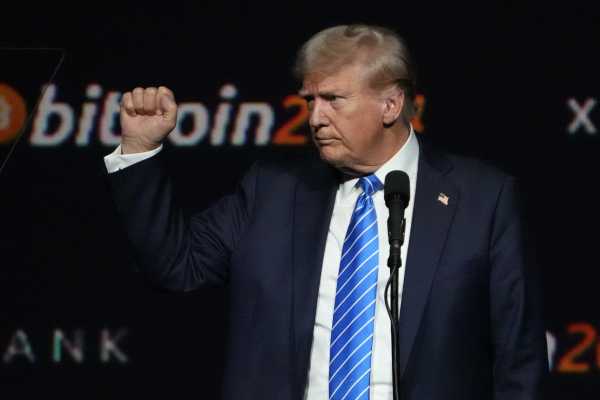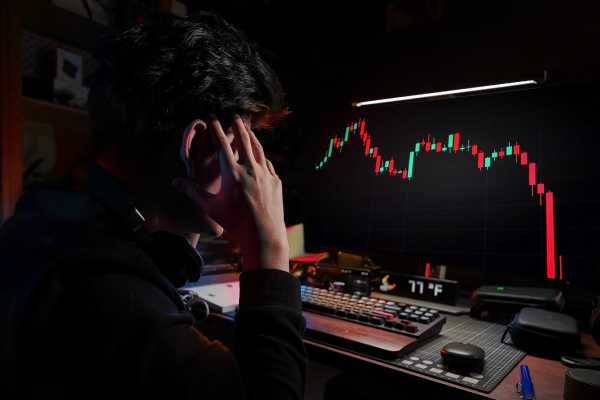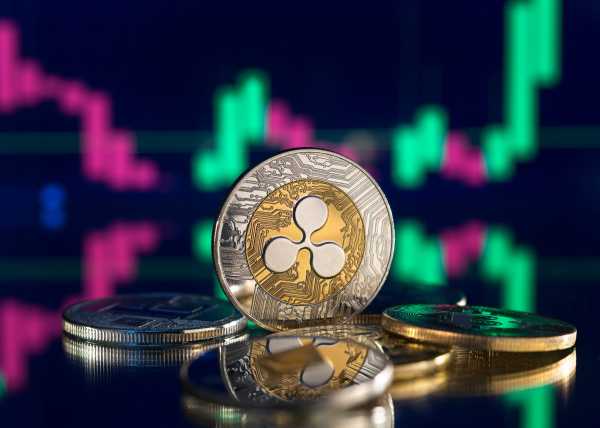Top 10 Crypto Exchanges With the Most Coins (Ranked)


Now that Bitcoin has made history by passing $100,000, crypto enthusiasts are rushing to invest in as many promising crypto tokens as possible. This means that the top crypto exchanges with the most coins will be in high demand over the coming months, as the current bull market continues and hits a new level of profitability. In this article, we’ll learn about the top centralized crypto exchanges (CEXs) with the most coins, and also discover the best alternative for traders and investors looking to capitalize on the most lucrative opportunities in the crypto market right now.
After reviewing the top major crypto exchanges with the most coins, we’ll also dive deeper into the topic of new crypto exchange token listings. Traders and investors often wonder why new tokens appear on some exchanges but not others, and ask some common questions about the general topics of new crypto tokens and new crypto exchange listings. We’ll address these important issues, and provide useful insights that can help you make more informed investment decisions.
Top 10 Cryptocurrency Exchanges With the Most Coins
| Exchange | Number of Coins | Number of Markets |
| MEXC | 2,651 | 3,327 |
| Gate.io | 2,437 | 4,096 |
| Bitmart | 948 | 1,188 |
| BingX | 893 | 1,167 |
| Bitget | 845 | 1,227 |
| KuCoin | 828 | 1,293 |
| HTX | 717 | 847 |
| Bybit | 695 | 1,073 |
| LBank | 671 | 914 |
| Binance | 444 | 1,712 |
Crypto Exchanges With the Most Coins Reviewed
As the table above shows, many of the top crypto exchanges offer hundreds and even thousands of crypto coins to trade and invest in. We’ll now consider each exchange in greater detail, ranking them by the total number of crypto coins available on each platform.
1). MEXC – The Crypto Exchange With Most Coins Listed
- Coins Supported: 2,651
- Markets Available: 3,327
- Trading Fees: 0.05%
MEXC is a favorite exchange for many traders and investors looking for maximum liquidity, low trading fees, and maximum trading and investment opportunities. With 2,651 crypto tokens and 3,327 trading pairs to choose from, MEXC users are spoilt for choice – and this diversity is backed up by market-leading liquidity. At the exact time of writing, MEXC’s real-time tradable volume (not daily volume) is over $30m on spot markets, with $70m in real-time tradable volume for futures traders.
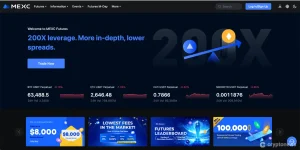
MEXC’s website uses live market data to compare the platform’s real-time liquidity to the second- and third-place exchanges. These competitors are currently Binance ($4m in real-time spot volume, and $18m on futures) and Bitget ($2.2m in real-time spot volume, and $24m on futures). If you’re looking to make whale-level moves, or simply minimize slippage when day-trading, MEXC is certainly worth looking into.
Beyond liquidity and having the most crypto coins listed, MEXC also boasts robust security measures, a dedicated mobile app, airdrops, loans, crypto savings options, fiat transactions, and more. Our analysts recently identified the best upcoming MEXC exchange listings, which can help traders and investors looking for high-value short-term gains.
Visit MEXC
2). Gate.io – Over 2,400 Coins With 4,000+ Markets
- Coins Supported: 2,437
- Markets Available: 4,096
- Trading Fees: 0.09%
Although MEXC is the crypto exchange with the most coins, Gate.io actually has more trading pairs – which have attracted the interest of advanced traders and investors who enjoy the challenge of trading between different cryptos. Gate.io consistently ranks among the world’s top crypto exchanges, and has developed a reputation for innovation – including the development of the first centralized NFT trading, creation, and auction platform (Gate NFT).
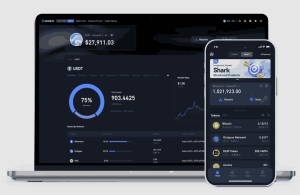
As traders and investors diversify into different types of crypto assets throughout the current bull run (including the top TRON meme coins), Gate.io is certainly a market leader for the most intrepid market participants. Its extended functionalities include copy trading, a token launch and airdrop feature, staking, savings, loans, trading bots, and a dedicated institutional product as well. Whatever your crypto needs, you’ll most likely find it featured on Gate.io – and you’ll also benefit from highly competitive trading fees.
Visit Gate.io
3). Bitmart – Exchange in Cayman Islands With 900+ Coins
- Coins Supported: 948
- Markets Available: 1,188
- Trading Fees: 0.25%
From this point in our review list, the number of coins available on the remaining major crypto exchanges falls below 1,000 – but that’s still a lot of tokens to choose from. Bitmart has opted for a balanced approach to its crypto exchange platform, which offers a strong mix of 948 tokens and 1,188 trading pairs alongside futures trading, NFT collections, copy trading, a dedicated offering for institutions, staking, a token launchpad, and more.
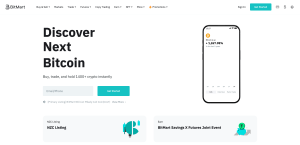
Bitmart’s focus on simplicity, and its concerted efforts to attract institution-level investors, have all contributed to its impressive success. Its user-friendly interface, highly advanced technical infrastructure, helpful customer support, and commitment to scalability and security also make Bitmart a good choice for traders and investors who need a consistent and reliable service.
Visit Bitmart
4). BingX – Top Singapore-Based Exchange With 880 Coins
- Coins Supported: 893
- Markets Available: 1,167
- Trading Fees: 0.1%
BingX has become an increasingly high-profile name within the crypto industry in recent years, and partnered with Chelsea FC – one of the world’s most popular and recognizable football teams – in 2024. With a particular focus on grid trading bots and copy-trading (alongside more traditional features such as spot and futures trading), BingX is looking to attract market participants who are keen to experiment with the very latest trading approaches. With almost 900 coins and 1,167 trading pairs, it’s also a great option for users who want to combine innovative trading techniques with a deep variety of crypto assets.

For users in compatible countries, BingX offers a quick and seamless signup process. Security-conscious traders and investors can also be put at ease by BingX’s proof of reserves feature, compliance-focused legal strategy, and its use of advanced AI tools in detecting risks related to cybercriminals and other bad actors. With high-profile business and infrastructure partners as diverse and respected as Chainlink, Moonpay, TradingView and more, BingX is clearly dedicated to providing a top-quality all-round crypto trading and investment experience.
Visit BingX
5). Bitget – 20 Million+ Users and 840 Coins to Trade
- Coins Supported: 845
- Markets Available: 1,227
- Trading Fees: 0.1%
For British crypto users (and market participants in over 100 other countries), Bitget has become a go-to exchange for advanced trading and investment options – especially futures trading, which enables traders to short the crypto markets and use powerful leverage to increase their profitability. AI-powered trading bots, easily accessible copy trading, and a readiness to embrace new and emerging crypto tokens at an early stage have all marked Bitget out as a crypto exchange to watch.

With 845 crypto coins to trade via 1,227 markets, Bitget might not offer quite the same variety as MEXC or Gate.io, but it is a helpful option for users who may be georestricted by other platforms. It’s also home to the Bitget User Protection Fund (which is designed to reimburse users affected by compromised accounts and asset theft), and is especially transparent when it comes to proof of reserves. Security-minded users can access Bitget’s latest reserve audit, view its cryptographic Merkle Tree hash, and see its real-time total reserve ratio – which is currently valued at 137% of users’ total assets.
Visit Bitget
6). KuCoin – Highly Secure Exchange With 800+ Coins
- Coins Supported: 828
- Markets Available: 1,293
- Trading Fees: 0.1%
One out of every four crypto holders use KuCoin when trading and investing, which is a great indicator of its positive reputation, reliability, and trustworthiness. In addition to now-familiar crypto exchange products such as spot trading, futures, grid bots and copy trading, KuCoin also stands out by offering leveraged tokens to eligible users. It’s also innovated by creating a new product called GemSPACE, where users can explore the always-popular landscape of crypto gems – tokens that have the potential to multiply in value dozens or hundreds of times over.

By prioritizing crypto gems and giving users access to potentially massive profits, KuCoin has become a popular destination for traders and investors looking to get the most out of the current bull run. It also refuses to compromise on security and transparency, implementing a robust proof of reserves facility alongside cutting-edge security measures. Users who remain unsure about joining KuCoin can start trading and investing with as little as $1, highlighting its accessibility and beginner-friendliness.
Our resident crypto experts recently identified the top upcoming crypto listings on KuCoin, which have the potential to deliver significant profits very quickly.
Visit KuCoin
7). HTX – Leading Asian Exchange With 700+ Coins
- Coins Supported: 717
- Markets Available: 847
- Trading Fees: 0.2%
Formerly known as Huobi, HTX chose to rebrand itself after aligning with Justin Sun, the founder of TRON and one of crypto’s most recognizable entrepreneurs. The “T” in “HTX” stands for “Tron”, and the company itself has embarked on a campaign of global expansion, making it potentially appealing to investors and traders looking to take advantage of the very latest industry developments.

Having already attracted over 47 million users, HTX ranks among the top 10 crypto exchanges in the world – meaning that traders and investors can always benefit from high liquidity levels. In terms of products, HTX offers everything from spot and futures trading to bots, DeFi, NFTs, copy trading, and crypto loans. This makes HTX a strong option for market participants looking for an all-round exchange that’s directly connected to one of crypto’s largest brands and entrepreneurs.
Visit HTX
8). Bybit – Second-Largest Crypto Exchange by Trading Volume
- Coins Supported: 717
- Markets Available: 847
- Trading Fees: 0.2%
Bybit has been competing with Binance and Coinbase for the overall top spot in the crypto exchange rankings for some time, and has invested heavily in marketing its products and services in as many countries as possible. It also has one of the best user interfaces and highest trading volumes in the entire crypto trading industry, which enables users to make lightning-fast moves. Bybit’s high-speed trading and matching engine further facilitates these quick and easy transactions, adding up to a fantastic user experience.
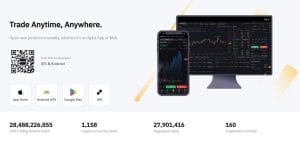
For futures traders in particular, Bybit is a top choice – and it’s also a favorite of crypto enthusiasts who enjoy watching crypto livestreams, which have strengthened its community and helped users learn the latest tips and tricks. Regular competitions, a focus on regulatory compliance, a willingness to integrate with as many high-quality blockchains as possible, and over 1,000 trading pairs make Bybit especially flexible. It may have a relatively low number of coins (695) compared to some others on this list, but its popularity is very nearly unmatched.
For traders and investors looking to profit from high-volume trading pairs, we’ve listed the best upcoming listings on Bybit – which are sure to make huge moves once they launch on this massively popular exchange.
Visit Bybit
9). LBank – Frequently Launches Coins in Innovation Zone
- Coins Supported: 671
- Markets Available: 914
- Trading Fees: 0.1%
Georestriction issues have become a significant concern for crypto users who want to stick with one exchange for the long-term – and since it’s available in over 210 countries, LBank is an outstanding choice. Futures traders will be happy with LBank’s leverage facility (offering up to 125x), and spot traders will also be able to dabble with leverage through specially designed ETFs (providing both 3x long and short leveraged options). The ability to profit beyond the limits of normal spot trading can be quite rare in some countries, so LBank is more than worth checking out if you’re an active trader.

With 671 coins and 914 trading pairs, LBank might seem to be one of the less flexible options on this list – but having introduced both an “Innovation Zone” and a “Meme Zone” for new tokens, they’re clearly becoming more open to expanding their range. Since the recent resignation of Gary Gensler from the SEC (a key financial regulator in the US), it’s likely that other regulatory bodies around the world will relax their rules around new crypto tokens. As a result, we could easily see exchanges with relatively few tokens begin to embrace the latest innovations and meme coins – just as LBank has.
Visit LBank
10). Binance – The Biggest Crypto Exchange in the World
- Coins Supported: 444
- Markets Available: 1,712
- Trading Fees: 0.1%
As the world’s biggest crypto exchange by trading volume, Binance needs little introduction – even for crypto beginners. It’s already bounced back stronger than ever following its recent legal battles, and Changpeng Zhao (Binance’s former CEO) remains one of the crypto industry’s most loved and respected thought leaders. Binance’s constantly expanding ecosystem includes educational resources (Binance Academy), a new token launchpad, NFTs, the Binance Labs Fund, Trust Wallet (a self-custody crypto storage solution), and much more.
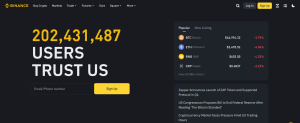
Today, Binance is more of a crypto empire than just an exchange – so traders and investors who want to be a part of the world’s biggest crypto CEX will find a welcome home there. If you love trading between exotic crypto pairs, you’re in luck: Binance may only offer 444 crypto coins, but you can trade those coins across 1,712 markets. That’s the third-highest number of trading pairs of all the exchanges we’ve reviewed here, behind only Gate.io and MEXC.
To discover the best upcoming and new Binance listings, check out our detailed guide for profit-seeking investors and traders.
Visit Binance
Which Exchange Lists New Coins the Most Often?
This usually depends on what kind of new coins are emerging at a given time, and a given exchange’s business strategy – which is always subject to change. For instance, if a lot of new meme coins hit the market at around the same time, some exchanges will be quicker to list those coins than their competitors (who may not list the new meme coins at all). On the other hand, if a new token is launched with clear utility and connection to well-established companies and projects, that token may launch on a lot of major exchanges at the same time.
As a general rule, crypto exchanges with the most coins are also the most likely to list new coins more often than others. However, the best way to maximize profits from an investment is to get in during crypto presales – which enable investors to buy tokens before they become available for trading on exchanges. We recommend Best Wallet as the top choice for investors looking to explore the world of crypto presales, as you can self-custody your crypto while also accessing the hottest and newest presales directly from the Best Wallet app.
Visit Best Wallet

Why Do Exchanges Have Different Numbers of Coins?
For investors and traders looking to maximize their opportunities in the crypto markets, it can seem strange or even frustrating that crypto exchanges vary dramatically in terms of the number of available cryptos to trade. Fans of new crypto projects also try to put pressure on centralized crypto exchanges to list their latest favorite token – but behind the scenes, listing new crypto tokens is rarely as easy as it seems.
When a major crypto exchange considers listing a new token, there are a number of factors that it must consider – and the project that created the token also has to decide whether or not a particular exchange is a good option. We’ll explore some of these deciding factors below.
Listing Criteria and Quality Requirements
Centralized crypto exchanges have come under increased scrutiny from governments and regulators over the last several years. Those powerful political entities can influence how successful a particular exchange is able to become in a given country – and even determine whether or not an exchange can even do business in that country at all. As a result, many centralized crypto exchanges are adopting increasingly stringent quality requirements and listing criteria for new crypto tokens and projects that want to be listed on those exchanges.
The precise quality requirements and listing criteria that a token or project needs to meet will vary from exchange to exchange. That said, factors such as the project’s technology, ability to meet roadmap milestones, the quality and reputation of its team, the strength and support of its community, its social media presence and audience engagement, and the amount of market demand for the new token will all be scrutinized by the exchange’s analysts before a new token will be accepted for consideration. Regulatory compliance is an especially important point that centralized crypto exchanges will raise during the review process, and we’ll go into more detail a bit later in this article.
During the application process for a new token listing, the project that created the token also needs to represent itself authentically and honestly, and take the listing process very seriously. If a project refuses to comply with an exchange’s requirements, tries to “game the system” by misrepresenting vital metrics, cannot verify the quality of its technology or team, does not communicate transparently and in a timely manner, or otherwise behaves unprofessionally, their new token can easily be rejected by the exchange – and the project may burn some bridges along the way. This kind of behind-the-scenes drama is a common reason why new tokens get listed on multiple major exchanges, but remain conspicuously absent from others.
Because of the sheer number of different listing criteria and quality requirements that may be involved in a new token’s review process, it’s useful to note that just because an exchange lists a lot of new tokens, that doesn’t mean it necessarily has lower quality standards. It’s simply applying a different set of requirements – and different exchanges also target their products at different types of traders and investors as part of their overall marketing and business strategies. Conservative crypto investors may be more drawn to exchanges that only list long-established projects and tokens, while more adventurous market participants will prefer exchanges that maximize their users’ choices – and they may leave a platform altogether if a rival exchange lists a favored token before anyone else.
Regulatory Compliance
As we noted earlier, governments and regulators hold the ultimate power over crypto exchanges around the world, as they can decide whether or not an exchange can operate in a country at all. They can also limit the exchange’s business operations even if they’re allowed to provide products and services, which in turn impacts the investors and traders who want to use the exchange in question. All of this makes regulatory compliance an essential part of any exchange’s business strategy, which then determines how exchanges approach new token listings and applications.
The exact regulatory requirements that a token or project needs to meet will mostly depend on which countries they want their coin to be listed in. Markets like the UK and US are highly regulated, and have strict rules about what crypto exchanges can and can’t do – but other countries can be less strict. Failing to comply with a country’s financial regulations can lead to extremely harsh penalties and reputational damage, so crypto exchanges generally emphasize compliance in order to gain an advantage over their competitors.

Blockchain Compatibility
Since crypto tokens are stored on blockchains, and not in crypto wallets (which are actually apps that enable users to interact with blockchains in various ways), crypto exchanges need to be able to interact with those blockchains in order for their users to buy and sell tokens. From a technological and infrastructure perspective, this gets very complicated very quickly – and if a particular chain does not yet have enough market demand in itself for an exchange to justify the resources needed to connect to that chain, then tokens on that chain will also remain out of reach.
This means that traders and investors who use that exchange will not be able to buy and sell particular tokens, which can be confusing and frustrating, and easily leads to missed opportunities. If those traders and investors want to trade a particular token strongly enough, they may move their funds to a completely different exchange where that token is available. This causes exchanges to lose customers if they do not connect their platforms to as many blockchains as possible.
For individual crypto projects and their tokens, it’s important to decide which blockchain to build on – ideally at the very beginning, when the project is first being built. A project that builds on a major Layer 1 blockchain like Ethereum (or a popular Layer 2 like Arbitrum, Base, or Pepe Unchained – our analysts’ top-recommended L2 project) will find it relatively easy to be listed on crypto exchanges, while projects that build on new and obscure L1 blockchains may not be able to get listed on certain exchanges at all. The most competitive crypto exchanges are constantly looking to expand their blockchain connectivity, but projects still need to make sure that they don’t end up too far ahead of the curve, as they run the risk of launching tokens that could take months or even years to be listed on major exchanges.
Cost Associated With Listing New Coins
On top of all the other factors listed above, a crypto exchange will usually require projects to pay a fee in order to get their token listed on that exchange. The size of these fees can vary dramatically – for instance, Bitget’s CEX listing guide estimates that fees can range from $200,000 to $500,000 or more, and may involve the exchange receiving a percentage of the total token supply (e.g. 5% to 20%). Like most business deals and legal arrangements, the actual amount an exchange charges as a fee will ultimately be determined by the exchange and project’s relative bargaining power (i.e. which party wants or needs the deal the most).
If a new project or token has a lot of hype, an all-star team, and overwhelming social media support (a clear indicator of market demand), it will have more bargaining power than another project that has a small social following, very little press coverage, and an unproven team of anonymous developers. This can make all the difference between a fee offer of $500,000 to $1 million, and an offer in the low six figures (or perhaps lower, in the case of mid-tier exchanges that operate below the major leagues). A highly skilled legal team can also be a huge deciding factor during fee and listing negotiations.

Should You Use the Exchange With the Most Coins?
As we’ve already seen, exchanges with access to the most cryptos don’t necessarily have lower quality standards than exchanges that only list relatively few tokens. In fact, it mostly comes down to the style of traders and investors that an exchange wants to attract, as part of their overall marketing and business strategies. Conservative investors might prefer exchanges with fewer tokens, and more experienced and adventurous traders might decide to maximize their opportunities by choosing the exchanges with the most coins.
Aside from the number of coins available for trading, there are a number of other factors that traders and investors should consider when deciding which exchange is the best for them:
- Security: Modern crypto exchanges employ the latest security technologies and techniques, but it’s always best practice to check the details and decide if you’re happy with the level of security available.
- Trading and Transaction Fees: These fees will reduce the profitability of your trades, and reduce the value of your transactions if they’re not taken into account when you transfer crypto from one wallet to another.
- Industry Reputation: Some traders and investors may prefer to use long-established exchanges, but this factor doesn’t necessarily guarantee that a particular exchange is the best. Newer exchanges may be more innovative, and motivated to provide significant advantages to users in order to attract a bigger audience.
- Liquidity / Trading Volume: As crypto exchanges gain more and more users, trading volume naturally increases. This can make it easier to execute the buys and sells that you want, at the prices you intend them to be valued at. This is an especially important factor for day-traders to consider, as well as “whale” investors looking to manage extremely large positions.
- Fiat Onramp and Offramp Capability: An exchange’s ability to allow its users to buy and sell crypto directly using their bank accounts and credit cards will normally be determined by the regulations of the country you live in, and whether or not the exchange complies with those regulations. If fiat transactions are not an option, you’ll still be able to send your funds to and from another platform with fiat onramp and offramp capabilities – which is less convenient, but sometimes unavoidable.
- Trading Interface and Analytical Tools: In order to execute trades as perfectly as possible, technical analysis tools (such as technical indicators and drawing tools) are truly invaluable. Most centralized exchanges provide at least some basic charts and tools, but users looking for the most advanced capabilities (such as personally customizable trading indicators that you can code from scratch) often choose external charting platforms, such as TradingView, while still executing trades directly on a CEX.
- Local Availability: Some crypto exchanges limit access to users in particular countries, which may mean limited products and services, or users being completely blocked from accessing an exchange altogether. When deciding which crypto exchange to use, it can be helpful to check the latest news and updates, just to make sure an exchange will provide the trading and investment options you need in your country.
- Proof of Reserves: This has become a hot topic in recent years, especially following the infamous collapse of FTX in 2022. It’s now common practice for centralized crypto exchanges to provide transparent reports about the crypto reserves and other funds that they hold to support trading and investing on their platforms. Decentralized oracle networks like Chainlink have created new technologies that increase confidence in such reports – and some exchanges even go so far as to offer protection funds that can reimburse users in the event of hacks and cyber attacks.
- Additional Features: Most modern crypto exchanges have expanded beyond simple trading, investing, and portfolio management options. From crypto staking to DeFi protocol access, margin and derivatives trading, OTC (over-the-counter) desks for whales, and (in some cases) access to the latest and best crypto presales, the race is on for crypto exchanges to give their users every opportunity to make money from crypto.
Taking all of the above items into consideration, our expert reviewers suggest that Best Wallet is the best overall pick for crypto traders and investors looking for crypto exchanges with the most tokens. Best Wallet has done an impressive job of staying ahead of the game when it comes to crypto presales – which allow investors to buy crypto tokens before they become available for trading. It also supports thousands of crypto tokens from over 60 blockchains, and uses enhanced security features such as 2FA (two-factor authentication), biometrics, and even third-party insurance through Fireblocks.
To continue researching and learning about Best Wallet, simply click the button below:
Visit Best Wallet
Conclusion
Choosing the best crypto exchange for your needs can feel overwhelming – but in this article, we’ve identified the crypto exchanges with the most coins and explored the world of new token listings. We’ve learned about the trading and investment platforms that provide the largest number of profit opportunities, and also considered all of the other factors that go into choosing the right centralized crypto exchange.
From here, we recommend signing up to not just one, but all of the different crypto exchanges that you feel would be good options for you. That way, you can try out and compare multiple platforms, and gain crucial first-hand experience of trading and investing on different exchanges. Personal experience is an important part of becoming a top-level trader and investor – and as crypto continues to expand its global userbase, the experience you gain will pay major dividends in the future.
FAQs
Which exchange has the highest number of coins?
The centralized crypto exchange with the most coins is currently MEXC, which allows users to trade 2,651 cryptos across 3,327 markets (trading pairs), according to CoinMarketCap.
How many coins does Coinbase have?
Coinbase currently has only 267 coins available for trading across 414 markets, according to CoinMarketCap.
How many coins does Binance have?
At the time of writing, Binance has 444 crypto coins available for trading across 1,712 markets, according to CoinMarketCap.
Which crypto exchange has the most trading pairs?
The major centralized crypto exchange with the most trading pairs is currently Gate.io, which has 4,096 pairs according to CoinMarketCap.
Which exchange lists coins the most often?
The centralized crypto exchange with the most coins is currently MEXC (with 2,651 cryptos available to trade), which indicates that they list coins at a higher frequency than most of their competitors. However, one of the best ways for investors to make money from crypto is through crypto presales – and Best Wallet enables users to access the best new tokens at the presale / ICO stage, before they become available for trading on major exchanges.
References
- CEX Listing Fees: Ultimate Guide to Crypto Token Listings (Coin Listing)
- CEX Listing Guide: A Must-Have Course for Founders (Bitget)
- Beginner’s Guide to Listing Tokens on CEX
(MEXC)
Source: cryptonews.com

